barn floor: dirt, clay, concrete
Hi all,
My barn is a bit rundown. Gradually, I'm fixing it up. Grand plans involve hobby (not commercial) chickens, and maybe any of ducks sheep, maybe alpacas, or dwarf goats. and who know, even a pony in 5 to 10 years when the kids get bigger. There were horses here at one time, but I'm not sure it's really big enough for that. There are four 9X9 stalls, and a T-shaped alley down the center and on two sides. Currently, it houses equipment and numerous groundhogs. It's quite worn and could use paint and some wood patchwork.
Phase 1 is done: repairing the board and batton siding and replacing the roof. Phase 2 looks like chickens, perhaps next spring. Some summers, a couple lambs already sleep in one stall and graze in the adjacent paddock (a bit under an acre, though parts are wet). Hopefully, this will continue.
The next thing will likely be chickens. I'm attracted to the chicken tractor concept, though maybe moving the lodgings inside a barn stall for the winter.
My big consideration at the moment is what to do about the barn floor. It's currently dirt. Very uneven, and the groundhogs are well entrenched. I'm wondering about smoking them out with Revenge bombs, but then what?
Concrete? Some say it's too hard on animal feet, and too chilly. Gravel covered with rubber mats? Or just rubber mats on the dirt floor?
I read in some book about a technique involving mixing concrete with dirt (3 parts dirt, 1 part concrete), to get a cheap surface with some advantages of concrete and some of dirt. Has anyone done this?
Please tell me what sort of flooring you think makes sense. The nicest small barn like this I've ever been to (Alderbrook Farm in S. Dartmouth MA) had concrete in the "halls" but dirt floor in the stalls. Not sure how they kept the varmints out, but it seems clean as a whistle. That's my only attraction to concrete: keeping out pests. I've never worked with the stuff, but would give it a try.
Thoughts?
--Jonathan
Comments (35)
flgargoyle
17 years agolast modified: 9 years agoThe method you mention is called soil cement, I believe. I've seen some driveways done that way. You till up the soil, add the portland cement, and mix it in thoroughly w/ a tiller. Then you have to wet it down to cure the cement.
Pipersville_Carol
17 years agolast modified: 9 years agoI like the dirt floor in my barn. A couple of years ago I put rubber mats in the horse stalls, and should have done it ages ago. They're great, they keep the bedding cleaner.
In the winter I spread wood shavings in the aisle. It helps keep the humidity down and seems to make the barn more comfortable.
The only downside to a dirt floor is burrowing vermin.
Related Professionals
Arnold Landscape Architects & Landscape Designers · Redondo Beach Landscape Architects & Landscape Designers · Medford Landscape Contractors · Bristol Landscape Contractors · Costa Mesa Landscape Contractors · Kahului Landscape Contractors · Snoqualmie Landscape Contractors · Washington Landscape Contractors · Wheat Ridge Landscape Contractors · Kendall Fence Contractors · Carlisle Decks, Patios & Outdoor Enclosures · Estero Decks, Patios & Outdoor Enclosures · Glasgow Decks, Patios & Outdoor Enclosures · Littleton Decks, Patios & Outdoor Enclosures · Palo Alto Decks, Patios & Outdoor Enclosuresdogridge
17 years agolast modified: 9 years agoI put down gravel screenings about 4" thick. If you compact them, they make a pretty hard surface. I did not compact and now the hay has mixed with the top layer and it gets pretty dusty. I mist it with water on occasion and that helps. Overall, the screenings were less expensive than concrete, drain well, and if properly installed (compacted) will have low dust.
Miss_Kitty
17 years agolast modified: 9 years agoOurs is similar to dogridges, it was very fine limestone, We wet it down and let the horses and traffic compact it for a couple of years. This winter I have swept out the surface stuff and have a nice hard floor. There are areas that are still gravel, but thats okay for now. The chickens use those spots for dustbaths.
It's pretty funny to see a couple of zoned out chickens wallowing in a mix of gravel and cedar sawdust.
We did put in a concrete floor in the feed room. To help keep the rats out. The cat lives there to work on the mouse population.
I'm looking into a stall flooring system for the horses, so far sawdust has worked well. I love the smell of cedar and popolar!
hoghaven_duluthmn
17 years agolast modified: 9 years agoIn areas where we fed or watered animals, we put down concrete pads so feed wouldn't get lost in the dirt and splashing water didn't develop into mud. Also in areas where the animals slept, we eventually put down concrete. However, we put down foam board insulation under the concrete to take the chill off the concrete. Also, having a concrete surface seems to help the wearing down of the hooves (not as much trimming). If an animal is injured or sick, it is easier to keep them clean on concrete -- you can scrape and disinfect. Also, parasites can live in the soil, reinfecting your animals. You can always put down plenty of straw for bedding. Just more things to think about. . .
bulldinkie
17 years agolast modified: 9 years agowe have stone,dirt with mats in horse stalls,concrete in barn itself,with mats..
Dibbit
17 years agolast modified: 9 years agoIf you are mainly concerned with keeping rodents, including woodchucks, out, then you need concrete. If the woodchucks have been living there for a number of years, then they have probably dug a fairly extensive network of tunnels, and as soon as you get rid of one, another will probably come along and occupy the lovely WC house. If you are around the barn every day, for several hours and several times a day, the woodchucks may leave on their own, as they aren't happy where there are lots of people. If you can shoot, trap or poison the present occupants - or do it as soon as they wake up in the spring, since they have probably gone to sleep for the winter by now - and establish a presence at the barn, you might get rid of them and not have them come back. But, you will still have to cope with rats, mice and voles, I am sure, so a cement floor where you plant to store feed, at a minimum, is good. And even then, I would store any feed in rodent-proof containers, whether purpose built or metal garbage cans. Mice LOVE hay and straw in the winter, as it's a nice warm, protected place for them to make their tunnels, with the bonus of at least some weed or grass/grain seeds to provide a readymade larder.
The next most important concern for underfoot in barns is drainage, which concrete, unless really well planned, with drains and/or a slope to a drain, doesn't really give you. For that reason, many people use clay, dirt, sand, gravel screenings, etc., for stall surfaces, laying down mats or the like to limit the amount of holes dug by hooves, and to make it softer - you need less bedding that way. There are mat-systems for stalls that have consideration for drainage - check out old copies of the magazine Equus as they have had several articles over the years, or google for stall mat systems - there are a LOT of them out there. But you REALLY NEED to allow for urine, etc., to drain away, else you get an ammonia and other odor build up, not pleasant, and very bad for your and the animals' lungs and eyes. There is a product called Sweet PDZ (bought at the local feed store for my brother's horses stalls/run-in-shed) which helps a LOT with odors, scattered on wet spots. It's much better than lime as less caustic, comes as either powder or granules, as I recall.
Whatever you end up with, you need to keep the surface level, as wet will collect in hollows, and they will get deeper, and an uneven surface is not good for any of the animals you would be keeping. Dirt and clay need to be replenished, and leveled, every few years, as would the screenings, though at wider intervals. You also need to give thought to ease of cleaning, and also to whether the area in any given part will get wet as a regular thing, in which case, I would probably put down concrete in those areas. The dirt-crete/soil cement might be a good alternative.
Ease of cleaning should probably be your next concern, so you need a level, firm surface for that also. Concrete aisles are much easier to clean than dirt ones, but not necessary to have. If you are going to be having animals giving birth in the barn, be it cows, goats, sheep or horses, then, as hoghaven said, being able to disinfect the area would be very nice. I'm not saying you HAVE to, and you may well have NO problems not worrying so much about infection, but all it takes is one bad experience.... As well, while it's not something you think of first thing, if you ever do have to nurse a sick or injured animal, it's really nice to know you are working in and with a CLEAN area, which you can really clean afterwards. Having one of the 'stall' areas in concrete, even if you don't do it with them all, since cement is expensive, would be very nice.
A 9 X 9 stall will work for ponies or smaller horses, or for horses that are out most of the time. My father put in 4 stalls that size when he built his last "barn", as he had no intention of keeping horses in 24/7. Naturally, one immediately cut itself badly and had to spend weeks/months on stall-rest! My brother, who lives there now, built a run-in shed that can become a 4-stall barn with 12 x 12 stalls, and turned 2 of the 9 x 9 stalls into a carport - a MUCH better use for them. But, 9 x 9 stalls will work for any animal that is smaller than a 16 hand horse.
Sorry for the screed, but as you can probably tell, I have opinions, and hope you wanted to hear them.
kydaylilylady
17 years agolast modified: 9 years agoWe have one hay/stock barn and 5 bent tobacco barns and all of them have floors of agricultural lime. This suits our purposes as we used to clean the barns with a tractor and front end loader and now use a skid loader. This way any part of the flooring that is scooped up and put in the manure spreader is no problem when it's applied to the fields. Since it's a natural material it allows drainage and when your floor gets to the point that you want to replace it you back a triaxle to the door and dump.
Lime doesn't get sloppy like dirt would and it lends enough traction for animals so they don't have as great a liklihood of slippage. It's economical as well.
This works well in bigger barns that aren't blocked off into stalls. It would also work with stalls but would be much more labor intensive.
Whatever you choose you need good drainage. Concrete may not necessarily keep your groundhogs and other rodents out as they will just tunnel underneath the concrete. Every surface has it's pluses and minuses. You have to decide what suits your budget and needs accordingly.
Janet
Jonathan
Original Author17 years agolast modified: 9 years agoVery helpful comments, thank you.
The issue of drainage has come up in various posts. Could you elaborate on how this works.
As in, should the floores have a slight slope, and where should the slope lead--out of the stall and into the alley, or somehow directly outside from the stall?
I'm doing a lot of reading about this, but am finding that directions stop short of saying exactly how to do it--where the rubber meets the road, for issues such as drainage.
--Jonathan
Dibbit
17 years agolast modified: 9 years agoWherever possible, drainage should go outside. In your climate, any standing water may/will freeze in the winter, leading to possible slipping, breakage, etc. If the stalls are lined with a material that will drain, than draining to the stalls from the aisle (think of a dropped water bucket, etc.) is MUCH better than the reverse. Planning drainage to the outside, to an open drain with its end sloped well away from the barn can work, as long as it is sloped and WELL away from the barn, so ice build-up doesn't block the end, nor make access to the barn impossible. Building a dry well, a fairly large pit filled with gravel, would be better; just site it where traffic, foot, animal and vehicular, won't run over it. You can, if cementing an area, slope the surface slightly so any liquid will drain to where you want it to end up; you can take a piece of PVC pipe and carefully make a trench at the edge leading to where you want things to end up. If you want to get fancy, you can dig trenches, set in proper drains, and have drains centered or at the edge of concreted areas, with the cement surface sloping to it. Just be aware that surfacing cement so it drains without puddles is NOT easy - the gut who did my basement missed an area or wasn't careful, and I have to sweep a puddle 3 feet over to the drain if I wash the floor - and HE does it for his living.
Another option, if not making an impermeable surface, is to slightly slope the base, get a slit pipe, such as is used at the base of foundations to allow for drainage there, and bury it along a back wall, leading the end out to the above mentioned dry well. You can put your surface material (clay, lime, gravel, dirt, screenings) over the pipe - wrap it well in a non-woven fabric like Reemay so dirt doesn't get in and block it. If you lay these along the wall, then hooves, etc. won't crush them.
Or, you can just be aware that you need to allow for it, not do anything that would make a mess of what is already there, and trust to whatever whoever was using the barn in the past did in the past. If the barn was in use for a number of years, then I am sure that whoever used it had to deal with such things and fixed any problems as they came up. If it appears that they didn't, then you will have to fix them yourself - just be careful not to create problem B in fixing problem A. And, it may be that while the barn was empty, things were done that did create a problem; I don't know what it looks like nor how it's laid out. The woodchucks may have created a mess of it also.
Yet another option, rather than relying on the advice of people who can't see the situation, is to contact your county Agricultural Extension office. The advisor should be able to come out, take a look and advise you what you can do, and what you should do. If the one in your county isn't available or helpful, sometimes the one from a neighboring county will help. They are free, and that's their job, answering questions and giving advice. They will probably also be able to give you a list of work-people who can help, but they WON'T say which one to use - they have to be impartial.
dogridge
17 years agolast modified: 9 years agoThe drainage in my barn is pretty good. We excavated about 4" of old dirt out of the barn before putting in 3 " of large gravel/crusher run, then another 3 " of the screenings. I was very concerned about drainage as our soil is clay, but so far we haven't had any problems. Our horses stay in for up to 12 hours, I usually put down shavings for comfort and absoption.
Dibbit
17 years agolast modified: 9 years agoPam, I would also double check the solidity of the footings for the stall floors - if the aisle got wet enough to rot, then wherever wood meets the ground in the stalls may also be rotten. Even though mini donkeys aren't very heavy, you don't need the floor to fall out from underfoot!
If it were mine, I would dig out the aisle a bit deeper, slope the base to an outside door, etc., providing some sort of drainage considerations away from the door, lay down the 6 in. of gravel, and then 2-4 in. of screenings over that, before laying down the mats. That way, there would be NO problem with water rising up through the floor and maybe floating the mats up off the base. Plus, the mats will go down on a smoother surface and not be likely to shift. You might also be lucky enough to find where the "stream" or drainage problem rises in the barn, and provide for directed drainage away from the barn aisle.
bulldinkie
17 years agolast modified: 9 years agoWe do like dogridge.No problems.I wouldnt have concrete in the stalls.
Jonathan
Original Author17 years agolast modified: 9 years agoIs "screenings" the same as "screened sand?"
Here's a supply list from a local supplier.
> http://www.powellstone.com/NewFiles/construction.html
My plan is 6 inches of gravel, 3 inches of screenings, and then rubber mats. I'm gonna do it stall by stall, or at least one stall now and then see how it goes.
There's a chance that a pony could move in any day. Or maybe not. It depends on how his relationship goes with a neighbor.
--Jonathan
Dibbit
17 years agolast modified: 9 years agoYou should probably ask at the gravel pit/operation, and look at samples. I will bow to superior knowledge, but to the best of my understanding, "screenings" are what falls out when crushed stone is run over a series of screens to get the larger, measured stones/rocks in roughly one size, i.e.; 3 in. gravel, 2 in. gravel, half in. gravel, etc. Crusher run (also called 'crush and run' locally), is all the sizes mixed together and not screened, which is why it's cheaper, but it all packs down pretty well too, which is why it's the material of choice for driveways, etc.
Screened sand, as I understand, is just that, dredged from a stream or river bed or dug from a gravel pit (AKA old river bed), but NOT recently crushed stone. Because it comes from a river or stream bed, sand tends to have smooth edges, so it packs down pretty tightly. You don't want that for stalls, as you WANT the drainage, so you want 'sharp sand' (which MAY in fact be screenings, I've never asked), which has sharper edges, so it doesn't pack tightly and the drainage stays good. I think screened sand is screened only to get any rocks and other matter out of it, as it's all much of a size.
As I said, I may be wrong on this, and am open to correction....
bulldinkie
17 years agolast modified: 9 years agoI always understood you do not use sand because it can pack in thier intestines.Everytime they eat off floor they get sand in thier mouth.Eventually it can pack inside the animal.
pamghatten
17 years agolast modified: 9 years agodibbit ... thanks for the reply and more to think about ... ;>). I certainly don't want my donks falling thru their stall floors!
I had thought that I might find the stream as we dug it out .. and I can definitely slope it for the water to exit out a door.
Happy New Year!
Dibbit
17 years agolast modified: 9 years agoBulldinkie, while horses can get sand colic, it's not all horses, nor because the sand packs solidly; it's because the sand "pools" in a low spot or a bend in the intestines and partially blocks the intestines. A lot depends on the animal, and if he/she drops a lot of grain that is subsequently picked up. Hay, if consistently eaten off sand, and if it has a lot of small leaves that drop off to be picked up, can also be a problem. Feeding on/over a mat or cement pad can limit problems, as can feeding extra fiber (flax seed, psyllium, beet pulp) or oil, to help push things through and out; this can be done in daily, small doses or a large monthly dose, and almost guarantee you won't have to worry about sand colic. Like a lot of things with horses, it's not something to obsess about nor to get paranoid about - you just deal with it. Certainly, if you ARE willing to deal with it, it's no reason to not use sand as a base for stalls, as long as the sand will drain properly. The main reason I wouldn't use sand in a stall, except as a base to go under mats, is that it doesn't pack down really well, so the bedding and manure mixes with it and is removed with each cleaning, so you have to keep "topping up" the stall levels. But it's used often enough - my brother has it as the footing in and outside his run-in shed, with mats over the area where the horses'feed tubs are, which gets swept several times a week, to get the sand which was in their hooves and fell out. His main concern there is for drainage and dry underfoot, so the sand works well for him. Because he doesn't use bedding in the run-in shed, even though some of the sand is removed as he picks up manure and rakes over the worst of the wet spots, it's not a lot of sand that gets gone - Sweet PDZ takes care of any odor from the urine.
mike112
17 years agolast modified: 9 years agoEver thought of Turtlemat? Try their unique Mud Hog or dirt trapper, or simply use their mats on the floor.
Here is a link that might be useful: floor coverings
Dibbit
17 years agolast modified: 9 years agoThe Turtlemat might indeed be a godsend inside a house or on a porch, but for in a barn, with livestock living on it, sorry, you might as well put down bedding such as you would use on YOUR bed, such as sheets and blankets, rather than bedding for livestock - straw, shavings, etc.. I can't even begin to imagine how you would clean the things, and imagining 25 or so of them across a stall floor, churned up and buried under the 15-25 pounds of manure and 10-15 gallons of urine a horse can produce in a day boggles my mind. In a word - NO!!!! I think Mike is very unclear on the concept, or trying to sell the mats, to be charitable.....
gduke2dogs_hotmail_com
15 years agolast modified: 9 years agoI have read through all of the posts looking for an answer to my rebuild problem. I am tossing out the issue and my proposed solution for everyone to pick at. All comments appreciated.
60+ year old oak barn 60x20x10 that has been used for chickens, horses and cattle. Existing floor is the original grade (clay with a healthy amount of manure mixed in) less what the stock has trampled, pawed and dug. The interior sits slightly lower than the exterior due to this wear and consequently takes in draining water from the south face. Following the rework of the floor this south face will again be walled off (with an 8' slider) and oak board. Water from damaged gutters will be rerouted as noted below and wherever possible, grade (exterior) will be re-sloped away from structure. A swale was dug 10 years ago to take rainwater from the west pitch.
All of the stalls were stripped out when we reinstalled new center 6x6 column posts and a new double 2x12 header that took out a lot of the sway.
Plan to provide underground drainage for livestock and removal of groundwater/runoff by extending drain tile outside to the south about 10' and running two trenches inside the barn equidistant from centerline. The lines will connect at the north end and exit the barn where it will tie into the swale. The gutters will drop downspouts into a pvc lead tying into the drain tile on both pitches.
The sub-grade of the barn will be sloped to the two trenches. A layer of poly will cover the dirt. The drain tile will be socked and surrounded in pea gravel. Coarser gravel will provide a 6-12" level base. Once compacted/rolled, a porous filter fabric will prevent lighter material (fines, sand etc) from clogging up the drainage.
My big question is once the sub-drainage is complete, what should be used for the floor base? I have thought about blue chip, limerock, clay and sand. Each has drawbacks but I am most interested in thoughts about the ability of waste (urine etc) to permeate the floor material and go downstream without too much grief. I will install an oak plank floor on sleepers over sand in the first 15 or so feet from the south to ease in shoeing etc but do not want an entire wood floor.
Beeone
15 years agolast modified: 9 years agoYou've got a pretty involved plan. I hope it isn't overkill.
First, make sure your drains are not going to be able to reach surface water. You want any drainage to remain in the swale and soak in before it can exit to live water. Otherwise, you are just running sewage into the stream and lots of regulators will be wanting to visit with you.
Your climate may be quite wet, but inside a barn with a good roof and siding, the only liquids should be from the animals and occasionally a spilled water trough. Unless you are into high numbers of animals confinement in small areas, I wouldn't think your floor could get wet enough to flow out the drain. With normal bedding/manure on the floor, your animals may be living in soup to get significant drainage. Make sure you have good ventilation and light in the barn to let it dry, and if you are keeping animals confined to stalls, change the bedding when it gets damp.
I think the plan to drain away from the exterior and raise/gravel the interior so water from outside cannot run in is excellent and should be all you need.
gduke2
15 years agolast modified: 9 years agoBeeone -
Thanks. Actually, the stock is rarely in the barn. Rare calving or calf issue or when I push horses inside to keep out of freezing rain etc. Pleanty of light from the east and when the sliders are open north/south there is usually a decent breeze.
I suppose my major concern is groundwater/rainwater. All of the troughs are outside. There is an old hydrant inside but the line is dead and I will probably not hook it back up. If the drain tile will get that problem away, then I may be able to save on the floor materials by ignoring permeability and use a sand and clay mix. Better for the feets, too. What about limerock? I read a comment above and that is both plentiful and cheap.
As to the swale/runoff, it extends through the first pasture and then downslope to the closest pond which is a couple of hundred yards. Lots of rich cover absorbs most of the current water, but that may change with the gutter tie in.
msjay2u
15 years agolast modified: 9 years agookay this may sound silly but it is something I was thinking of and wanting a response. I wanted to put in a cement floor in my coop but I have discovered the bags to be extremely heavy and when I can get it in the wheel barrel it is hard to mix it up. SO I was thinking of opening a few bags of cement pouring it out in the pen, smoothing it out with a rake and then taking a water hose and soaking it thoroughly with water. No mixing involved and then let it dry smoothing it out as necessary.
What is the purpose of this? To stop anything from digging into the pen. What would happen if I did it like this? Any ideas?
gduke2
15 years agolast modified: 9 years agomsjay2u -
This would result in a floor that falls apart very quickly. The purpose of mixing the concrete is to insure a uniform adhesion of aggregate (stone) bonded withing the sand/cement mixture. While placing bags of concrete mix in a stream will result in a usable dam and dry packing concrete around posts will result in the absorbtion of groundwater (an moisture from the wood) to form a more stable base, the proposed plan will result in a floor with no strength and subject to rapid cracking as it dries out.
Best bet is to get a couple of friends to help, mix the concrete in small batches and level with a 2x4 after placement; do not try to mix the entire bag at once because it will be hard to get a uniform mix before everything starts sticking. A rental place can offer a small gas or electric mixer that may help if you are working alone. Try to start early in the day to avoid heat.
For a more durable slab, place several inches of sand (compacted) or gravel under your slab. A layer of poly between the subbase and the concrete will keep the slab from drying too quickly (the ground will absorb moisture from the concrete mix) and limit cracking. Pay attention to the mixing directions, esp. water volume. A wet pour will have less strength.
All concrete will crack over time but since this slab won't have a lot of weight on it it should serve for a long time.
msjay2u
15 years agolast modified: 9 years agoIf it breaks up will it keep critters from digging through it?
tonyinmichigan
14 years agolast modified: 9 years agoInteresting, and useful thread! I do not have animals, but am putting up a barn this summer. I plan to use 3-4 inches of Crusher Run, followed by 2-3 inches of fine lime. My understanding is with water and compaction I will have a solid floor with flexibility. I intend on leaving room for cement in case the future holds this type of change. Question for the members, have you heard of somone laying plastic under the Crusher Run? I would think this would avoid ground condensation, and damage to cars etc parked in the barn. Thoughts?
pamghatten
14 years agolast modified: 9 years agoThe person who re-did my barn floor, tore out the rotted wood and laid stone ... put down a fabric that is used when they put in roads. It helps to stop the stone from quickly disappearing into the ground.
I personally wouldn't put down plastic, my area is too wet.
gduke2
14 years agolast modified: 9 years agoOk; back in February I mentioned rebuilding/replacing the floor in the old barn. There has been a delay in posting but the finishing touches on the floor/drainage were put in last week. As usual, first there was the plan, then there were the assumptions and then there is what actually happened.
Got the old floor dug out early spring and installed 1 run of drain tile with sock. Drain tile set about 18" sloping to 10" deep under stall side of barn and run to daylight.
After digging out the old manure and leveling the floor, we installed 8-12" of #10 crushed limestone over the native clay. This resulted in the interior floor about 8" higher than the surrounding. The new floor is completely level compared to the existing (sloped) exterior grade.
Last week we finished installing the exterior drain tile with sock; due to drainage/slope the tile is only about 6-8" below finished grade but since the problem has always been surface water not underground I am as yet unconcerned. One exterior run of tile is tied in with the interior run and they continue to daylight; the back side has its own run.
Both exterior runs have stub-ups for gutter tie ins but since we left the top gravel (#57 blue stone - 3/4 - 1-1/2")exposed I may not install the gutters. If so, I will cap the openings with Fernco's. Water dripping off the roof hits the gravel, enters the drain tile and runs out away from the barn to the existing drainage swale.
Have not had much rain yet but seems to work well with what we got last weekend. The new floor has been blocked off and stock limited to first 20'; the crushed limestone is easy to maintain and there does not seem to be any difficulty with odor or manure drainage/removal.
Next stop - replacing/reinstalling wood ends, sliding doors and damaged siding ... and new lightning protection for all of the structures.
lefthandfarm_yahoo_com
13 years agolast modified: 9 years agoWith regard to "screenings", "screened sand", "crusher run", etc., I think there are some regional differences involved, both in the terminology and the geology (meaning what type of stone is available). I moved from Connecticut where most of the state is made of gravel (mostly from granite or similar I think), to central West Virginia, where most of the soil is made of clay and the stone is mostly shale. In CT, I never heard of "crusher run". We used to get "bank run", which was gravel just the way it came out of the ground, and it did not compact to a hard surface like "crusher run" does. I have "crusher run" on my new driveway here in W.Va., and it does compact to a hard surface, and I think it is because of the stone dust that is in it, which is a result of the type of stone being crushed (limestone brought in from Ohio?). I'm not an engineer or geologist, but that's the way it seems to me. I never heard of "screenings" before, either. In CT we just got "screened sand", either grade A (for brick mortar), or grade B, slightly coarser, good for sanding your icy driveway. (I've also noticed nobody does that here in W.Va. Apparently sand is not as readily available here as it is in CT.)
ryegrassman_lindy_gmail_com
13 years agolast modified: 9 years agoMy goat shed was built on the ground and now 5 years later the plywood flooring is unsafe to walk on. Therefore, I am going to use a ripsaw around the perimeter and put new 2x10's in a rectangle around the perimeter of the barn. It will be about four inches away from the current walls. I plan to put drainage pipes run through the wall on the low side out to the garden beyond. Then my plan will be to cover over the pipe and the inside of the 2x10's with 4 inches of gravel then put a layer of lime. The final layer will be to pour conrete in the rectangle which should be about 4". When the concrete drys I should still have two inches to put stall mats and a layer of stall pellets for absorbtion of urine and for ease of cleaning. The drainage pipes will be covered with gravel.
Does this sound like a good plan???
ferozekash_yahoo_com
12 years agolast modified: 9 years agoHI ALL
i am really lost in all those tips.
i can'nt figure out between rocksand anad sand.
Rocksand does not pack up but create dust when dried up while cleaning.
sand does not create dust but compact and you lose more while cleaning ,is better to keep diesease out some claims it retain fleamro777
12 years agolast modified: 9 years agoWe have a very large metal barn with concrete footings but due to cost at the
time of construction we left the floor dirt (clay) the barn is essentially for the
storage of tractors, 4 wheelers. The main problem is the dust and dirt, every thing is so dirty. Does anyone have a suggestion for making the floor less
dusty?gduke2
12 years agolast modified: 9 years agoTo clarify some of the stone issues: in VA/WVA, much or our stone is limestone and/or gravel from other harder materials. The sizes are specified by DOT for roadwork and those are the names commonly used. Fines (small particles, dust etc) included in the mix allows for the compaction to give Patrick his driveway. Crusher run is often crushed, recylced concrete not quarried stone - it will include aggregate from the concrete mix and a lot of dust that fills the voids and allow for more dense surface.
The quarry sorts materials by size through screens (hence screenings).
I used #57 stone (3/4 - 1-1/2") as base and the used #10 fines (I think that is the screen size) for my finished floor.
Talk to your local quarry and look at their sample piles - as Patrick said, local terms may vary. And we do have sand.

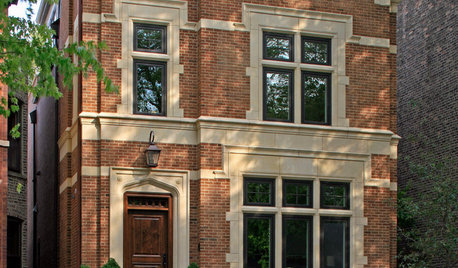
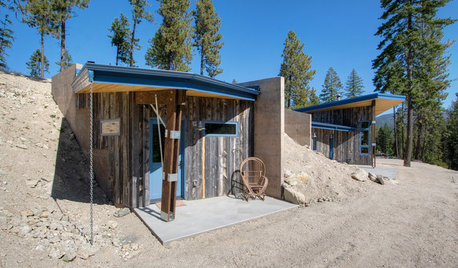

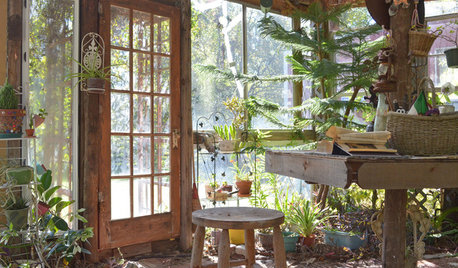
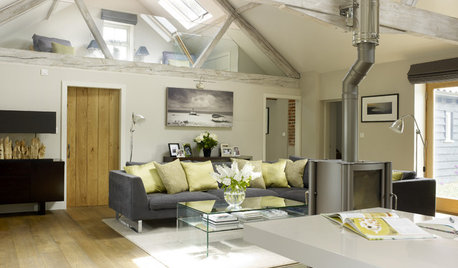
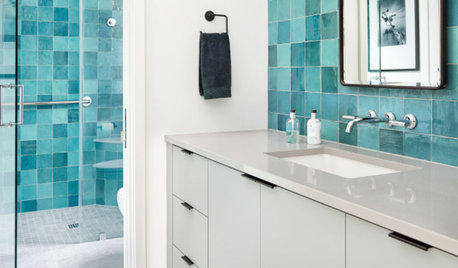


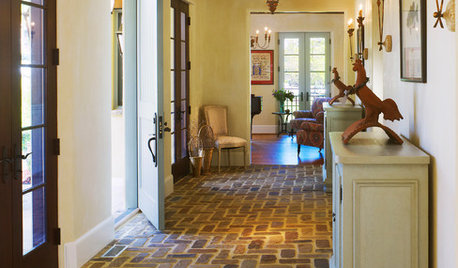






pamghatten